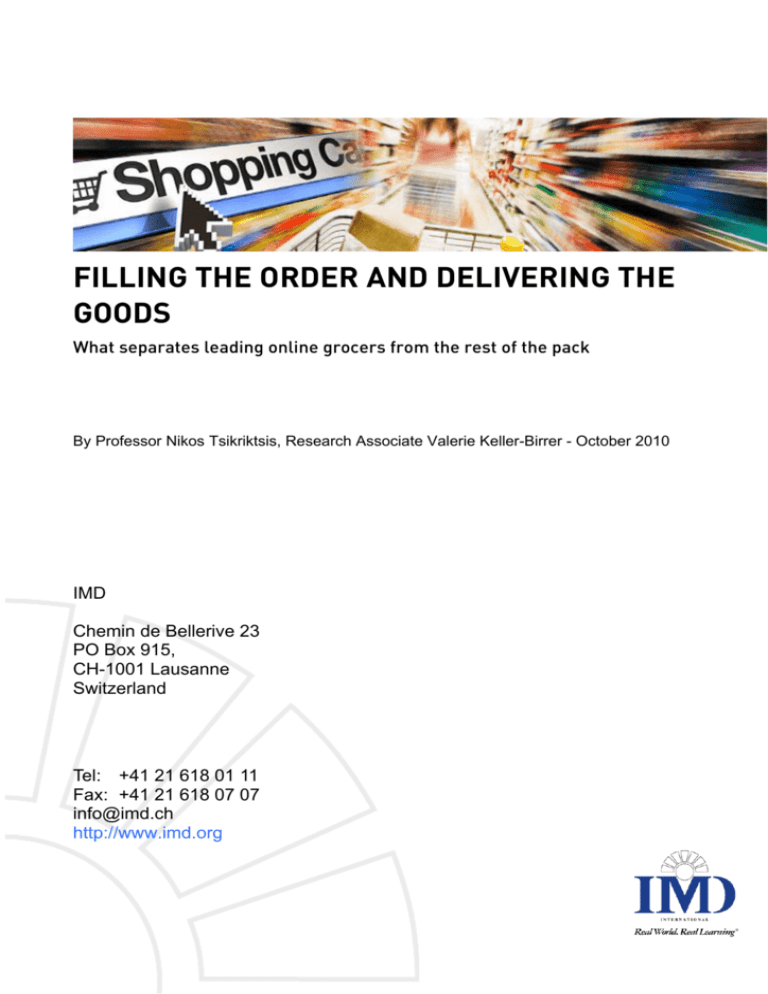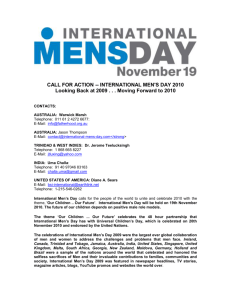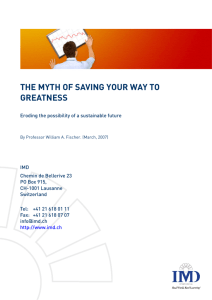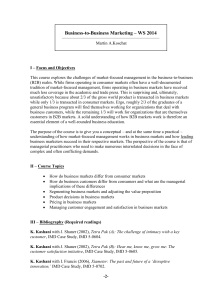filling the order and delivering the goods
advertisement

FILLING THE ORDER AND DELIVERING THE GOODS What separates leading online grocers from the rest of the pack By Professor Nikos Tsikriktsis, Research Associate Valerie Keller-Birrer - October 2010 IMD Chemin de Bellerive 23 PO Box 915, CH-1001 Lausanne Switzerland Tel: +41 21 618 01 11 Fax: +41 21 618 07 07 info@imd.ch http://www.imd.org FILLING THE ORDER AND DELIVERING THE GOODS I What separates leading online grocers from the rest of the pack The online grocery market is one of the most dynamic sectors in the retail industry. In recent years it has shown impressive growth rates, despite fierce competition and characteristically low profit margins. On the other hand it is also one of the most logistically challenging sectors, so there have also been plenty of businesses that have fallen while attempting to gain a handhold in the market. In fact, companies have been fighting for a share of e-groceries since the late 1990s, but very few have managed to build and run profitable businesses. Wellpublicized failures include start-up companies such as Webvan and Streamline in the US, which went bankrupt shortly after launch. So, which of the competing logistics models is best placed to meet the many challenges facing businesses running online grocery options? Filling the order One of the first choices facing online grocers is how to get the customer’s order into his or her shopping bags. There are three models available: 1. The central warehouse. This is a purpose-built, automated distribution center that is designed and built specifically to fill online orders. At least part of the process is computer based, which minimizes mistakes and thus increases customer satisfaction. It is operationally efficient and, once critical mass is achieved, it is more cost effective than other models. For example, Ocado, a British grocery retailer, claims that its dedicated distribution center can handle the same order volume as 25 supermarkets and that it can pick 300 items per hour – roughly three times the rate achieved by instore pickers at Tesco. However, initial costs with this model are higher, which means that the retailer will need to build up volumes quickly if it is to take advantage of the center. Most online-only retailers – those that are not an arm of an established supermarket – use this model as they do not have any existing infrastructure. 2. In-store picking model. Many bricks and mortar supermarkets that have added egroceries to an established business use this approach, which relies on existing supermarkets rather than a central warehouse. It has the advantage of a low initial cost – Tesco only spent €43 million launching its online operation – which allows for fast, IMD – www.imd.org Page 2/6 FILLING THE ORDER AND DELIVERING THE GOODS I What separates leading online grocers from the rest of the pack low-risk expansion. It also minimizes delivery distances, as picking up takes place at the store nearest the customer’s home. On the down side, it is less efficient, as in-store shelves were designed with the customer experience, rather than the demands of an online retail operation, in mind. It can be difficult to have all items in stock, and, as demand grows, picking can get in the way of other shoppers as stores reach the limit of their online order capacity. 3. A hybrid model. With both models showing shortcomings, a third hybrid solution is emerging, combining the dedicated warehouse model with in-store or smaller warehouse picking. In 2006 Tesco moved part of its operations into one central warehouse to offset some of the limitations of in-store picking. Delivering the goods Getting the goods to customers, on time and at the appropriate temperature, is one of the most important success factors. Customers have high expectations of delivery, flexibility and accuracy. The e-grocer has to commit to a specific delivery window and must ensure that refrigerated and frozen goods stay at the right temperature. There are several options available: 1. Own delivery operation. Many e-grocers consider it a strategic advantage to operate their own delivery fleet. It means that they have full control over the delivery operation and can use it to build a relationship with the customer. Ocado operates its own delivery operation of over 500 specially designed home delivery vans, allowing it to offer stateof-the-art home delivery in a one-hour delivery slot. Tesco and Peapod, an online grocery delivery service operating in select US cities, also operate their own delivery operation, however with two-hour delivery windows. 2. Outsourcing delivery. Some online grocers delegate delivery to a third party such as a logistics company or an express delivery service. This allows the retailer to delegate the difficult task of planning daily routes to a specialist with delivery experience, allowing it to focus on other aspects of the business. LeShop, an online pioneer which began IMD –www.imd.org Page 3/6 FILLING THE ORDER AND DELIVERING THE GOODS I What separates leading online grocers from the rest of the pack selling groceries on the internet in 1998, is an example of this. It almost went bankrupt in 2002, however after joining forces with Migros, Switzerland’s largest retailer, LeShop became the first pure play e-grocer to break-even in 2006. 1 This approach does not require any investment in delivery infrastructure, and is flexible in case of demand fluctuation. However, it is risky in that the e-grocer delegates control over the operation. It also represents a lost opportunity to build a relationship with the customer. 3. Alternatives. The latest option is “third location deliver”, also called “click and drive”. The customer orders the groceries online and picks them up at a pre-determined location. This can take place either at a location owned by the grocer - a supermarket or a specially designed warehouse - or at a third-party location, such as a gas station or post office. This solution allows the e-grocer to save delivery costs, while increasing customer satisfaction with an additional service. Another option is unattended delivery using an insulated box. This lets the e-grocer optimize its delivery routes and is a convenient solution for the customer who does not need to be present at the time of delivery. However this method has some drawbacks: the cost of the delivery boxes is relatively high and delivery into apartment buildings might not always be possible. No one right solution In the early days of online supermarkets the low-cost, low-risk business model of in-store picking run by an established retailer seemed the most promising model. Now, in a more mature market, online-only retailers can succeed where they failed a decade ago. Despite this, no single logistical model has emerged as the ideal. The in-store picking model seems more appropriate in low demand markets, but once critical volume has been achieved the central warehouse model is more efficient. Some online grocers have recognized this and are experimenting with hybrid approaches, combining in-store picking for roll-out in new markets with efficient central warehouse picking in high demand areas. Equally, grocers are facing a trade-off between offering the best possible delivery service, and logistics efficiency. In order to meet these challenges, they have been looking at alternative IMD –www.imd.org Page 4/6 FILLING THE ORDER AND DELIVERING THE GOODS I What separates leading online grocers from the rest of the pack delivery solutions, ranging from third location delivery at the supermarket or at a third party, to unattended deliveries with specially designed boxes. Given that the market is barely a decade old, it seems likely that technological innovations will add new possibilities to be considered in future years. Nikos Tsikriktsis is Professor of Operations and Service Management at IMD. He is the director of IMD’s Building on Talent program. 1 LeShop corporate information (http://info.leshop.ch/php/BusinessLeShop.php?LeShopMenuId=159&lge=uk) IMD –www.imd.org Page 5/6 FILLING THE ORDER AND DELIVERING THE GOODS I What separates leading online grocers from the rest of the pack RELATED PROGRAMS BUILDING ON TALENT - http://www.imd.org/bot Developing the next generation of leaders Program Director Jack Wood - Prepare and position yourself for a higher level of responsibility - Increase your global awareness, business knowledge and capacity to exercise leadership responsibly - Integrate and apply your learning to your company through a real-life project - Get ready for IMD’s Executive MBA degree MANAGING THE GLOBAL SUPPLY CHAIN - http://www.imd.org/mgsc Growth through productivity and efficiency - Understand and manage global supply chain complexity and risks - Protect sales and revenue growth through efficient execution of sustainability programs - Anticipate surprises and avoid problems within your global material, information and financial flows - Explore collaboration and various forms of integration that allow you to take advantage of uncertainty IMD –www.imd.org Page 6/6




